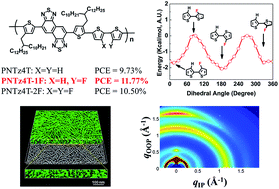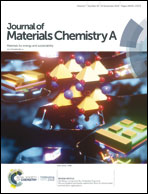High-efficiency non-halogenated solvent processable polymer/PCBM solar cells via fluorination-enabled optimized nanoscale morphology†
Abstract
PNTz4T-based polymers have been extensively employed in high-efficiency fullerene-based polymer solar cells (PSCs) with a power conversion efficiency (PCE) of approximately 10.0% due to the high crystallinity of these polymers. The introduction of two fluorine atoms into PNTz4T to synthesize the PNTz4T-2F polymer has boosted the PCE to 10.6%, but the introduction of four fluorine atoms to synthesize the PNTz4T-4F polymer negatively affects the efficiency (PCE = 6.5%), implying that the number of fluorine atoms is not yet optimized. We have developed a new synthetic route for a novel monofluoro-bithiophene monomer and successfully synthesized a novel PNTz4T-1F polymer. The fullerene-based PSCs based on our novel PNTz4T-1F polymer processed using a halogen-free solvent system demonstrated an outstanding PCE of 11.77% (11.67% certified), representing the highest PCE reported thus far in the literature. Due to the optimum molecular ordering/packing, improved interaction with PC71BM and interconnectivity between photoactive material domains, PNTz4T-1F-based PSCs exhibit lower charge carrier recombination and enhanced charge carrier mobility levels, leading to a substantially high photocurrent density (20.37 mA cm−2). These results create new means to tune the structural properties of polymers, ultimately leading to the realization of this class of solar cells for practical applications.



 Please wait while we load your content...
Please wait while we load your content...